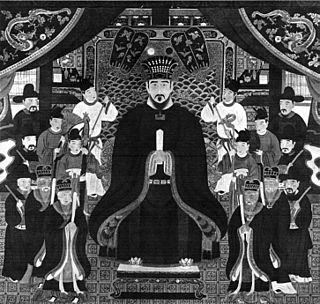Related Research Articles

The Shimazu clan were the daimyō of the Satsuma han, which spread over Satsuma, Ōsumi and Hyūga provinces in Japan.

Shimazu Takahisa, a son of Shimazu Tadayoshi, was a daimyō during Japan's Sengoku period. He was the fifteenth head of the Shimazu clan.

Shimazu Yoshihisa was a powerful daimyō and the 16th Chief of Shimazu clan of Satsuma Province, the eldest son of Shimazu Takahisa. He was renowned as a great general, who managed to subjugate Kyushu through the deft maneuvering of his three brothers. Eventually, in 1585, Yoshihisa seceded control of the entire Kyushu region.

Shimazu Yoshihiro was the second son of Shimazu Takahisa and the younger brother of Shimazu Yoshihisa. Traditionally believed to be the 17th head of the Shimazu clan, he was a skilled general during the Sengoku period who greatly contributed to the unification of Kyūshū.
Kimotsuki Kanetsugu was the sixteenth head of the Kimotsuki family and the son of Kimotsuki Kaneoki. Kanetsugu was a skilled and smart leader, but his domain happened to be next to that of the most powerful clan in Kyūshū, the Shimazu clan, and the Kimotsuki family would be defeated by them.

Shimazu Tadayoshi was a daimyō of Satsuma Province during Japan's Sengoku period. He was born into the Mimasaka Shimazu family (伊作島津家), which was part of the Shimazu clan, but after his father Shimazu Yoshihisa died, his mother married Shimazu Unkyu of another branch family, the Soshū (相州家). Tadayoshi thus came to represent two families within the larger Shimazu clan.
Iriki-In Shigetomo, the son of Iriki-In Shigetoshi, was a vassal under the Shimazu clan of Satsuma. The lord of the Shimazu clan, Shimazu Katsuhisa, suffered the rebellion of a kinsman, Sanehisa, and was forced to flee Satsuma during 1526. The Shimazu clan head was then passed on to Katsuhisa's eldest son, Shimazu Takahisa. Even though Takahisa was the new head, Katsuhisa still had authority over a good amount of land. Considering Shigetomo's lands were very close to that of the Shimazu's, he found himself in conflicts between the Sanehisa around Momotosugi.

The Kyūshū campaign of 1586–1587 was part of the campaigns of Toyotomi Hideyoshi who sought to dominate Japan at the end of the Sengoku period. Having subjugated much of Honshū and Shikoku, Hideyoshi turned his attention to the southernmost of the main Japanese islands, Kyūshū.

Kagoshima Castle was an Edo period flatland-style Japanese castle located in the city of Kagoshima, Kagoshima Prefecture, Japan. Its ruins have been protected as a National Historic Site since 2023. Kagoshima Castle was listed as one of Japan's Top 100 Castles by the Japan Castle Foundation in 2006.). It is more popular known in Kagoshima as Tsurumaru Castle (鶴丸城)

Shō Nei was king of the Ryukyu Kingdom from 1589 to 1620. He reigned during the 1609 invasion of Ryukyu and was the first king of Ryukyu to be a vassal to the Shimazu clan of Satsuma, a Japanese feudal domain.
Shimazu Toshihisa was a Japanese samurai of the Azuchi-Momoyama period, He called 'Saemon no kami'. he was a third son of Shimazu Takahisa, who served as a general officer and senior retainer of the Shimazu clan of Satsuma Province.
Shimazu Iehisa was a Japanese samurai of the Sengoku period, who was a member of the Shimazu clan of Satsuma Province. He was the fourth son of Shimazu Takahisa. He served in a command capacity during his family's campaign to conquer Kyūshū.
Kimotsuki Kanetake (肝付兼武) (1823–1888) was a retainer, and scholar for the Shimazu clan of southern Kyushu during the late Edo period
The siege of Kōriyama Castle was fought in the 1544. The Iriki were vassals of the Shimazu clan and Iriki-In Shigetomo was the brother-in-law of Shimazu Takahisa. However relations began to sour when rumors spread that Shigetomo was plotting a rebellion against Takahisa. In 1544 Shigetomo died and shortly after Takahisa attacked and captured his castle of Kōriyama, ending any menace the Iriki-in could pose to his rule. Iriki-in Shigetsugu succeeded Shigetomo and the relations were later restored between both sides.
The Battle of Ichirai (市来鶴丸城の戦い) was fought in 1539 between two rival factions of the Shimazu clan.
The siege of Kajiki was fought in 1549. The Shimazu clan besieged the castle of Kajiki in what is now Kagoshima prefecture, Japan. The siege succeeded and the castle was taken. The siege is notable for the first time "Portuguese derived" arquebuses were used in battle in Japan.
The Shimazu Estate was a shōen in southern Kyushu of Japan, covering large portions of Satsuma, Ōsumi and Hyūga Provinces. It was the largest shōen of medieval Japan. The Shimazu clan took its name from this estate as the clan succeeded the position of jitō.

Shibushi Castle was a Muromachi to early Edo period hirajiro-style Japanese castle located in the city of Shibushi, Kagoshima Prefecture, Japan. Its ruins have been protected as a National Historic Site since 2005.

Sadowara Domain was a feudal domain under the Tokugawa shogunate of Edo period Japan, in what is now central Miyazaki Prefecture. It was centered around Sadowara Castle in what is now the city of Miyazaki and was ruled by a cadet branch of the tozama daimyō Shimazu clan for all of its history.
References
- ↑ "SHIMADZU HARUHISA'S GRANTS AND OATHS, 1462 AND 1466". Archived from the original on 2012-03-28. Retrieved 2011-09-04.
- ↑ "Samurai-archives". Archived from the original on 2019-10-30. Retrieved 2011-09-04.